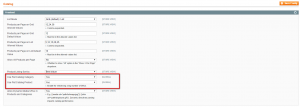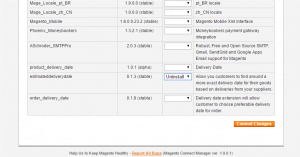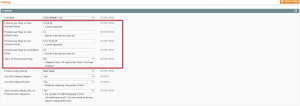If you use Magento as your ecommerce solution – lucky you! If not, there are lots of reasons why you should consider it. Magento has an extensive list of features, phenomenal support, the flexibility for you to manage your own ecommerce business, and is the most popular web shopping cart in the world, used by leading businesses and brands. However, Magento site performance optimization is a key aspect of a successful Magento site.

Third-party benchmark tests show Enterprise Edition 1.14.1 provides faster server response times and CPU utilization rates versus previous versions. A faster site seems like a better shopping experience for your customers, which in turn, will drive conversion rates and sales.
If you are using an early edition of Magento, or perhaps your configurations and settings are not applied correctly. Your site may benefit from some easy Magento site performance optimization tips. Let’s face it, a faster site can impact sales dramatically. 47% of consumers expect a web page to load in two seconds or less and a one second delay can kill conversions by as much as 7%.
A faster site, equals happy customers and more sales. A slow site will drive customers away from your website to buy from a competitor. There are several methods that you can use to increase Magento speed, and we have assembled a list of 10 High Impact Magento Speed Optimization Steps.
10 High Impact Magento Site Performance Optimization Steps
#1 First of All, Turn on Magento’s built in caching
This will automatically clear out the cache, keeping the server load as low as possible, speeding up your store.
- Log into admin
- Go to System ► Cache Management
- Select “All Cache Types”
- Also, in the “Action” drop down menu, select “Enable”
- Finally, click “Submit”

#2 Enable “Merge JavaScript Files” and “Merge CSS Files” to reduce the number of http requests.
Combining all JavaScipt and CSS files into one file will make your pages load much faster.
- Log into admin
- Go to System ► Configuration
- On the left hand side, go to “Advanced” and select “Developer”
- Select “Merge JavaScript Files”
- Change drop down to “Yes”
- Also, click “Save Config”
- Select “CSS Setting”
- Change “Merge CSS Files” to “Yes”
- Finally, click “Save Config”

#3 Enable “Use Flat Catalog Category” and “Use Flat Catalog Product” to decrease database queries.
All features that apply to Categories and Products are stored in separate database tables. Flattening will put all features in one table for Magento to retrieve. This will help optimize your Magento store, this is especially critical for larger sites with 1,000+ products.
- Log into Admin
- Go to System ► Configuration ► Catalog ► Catalog ► Frontend
- Also, change “Use Flat Catalog Category” and “Use Flat Catalog Product” to “Yes”
- Finally, click “Save Config”

#4 Uninstall any extensions that you don’t actually use.
If you aren’t using them, why not delete them? Simple, yet doing so is an easy Magento speed optimization trick.
- Log into admin
- Go to System ► Magento Connect ►Magento Connect Manager
- Log in with your admin username and password
- Also, select which extension you would like to install
- In the “Action” drop down menu, select “Uninstall”
- Finally, click “Submit Changes”

#5 Limit the number of products on a product overview page.
This will help your pages to load faster as there are fewer images and information that the browser will have to pull in.
- Log into admin
- Go to System ► Configuration ►Catalog ► Catalog ► Frontend
- Also, adjust the number of products shown on pages.
- Finally, click “Save Config”

#6 Enable cron and log cleaning.
Magento stores a lot of logging information in the database tables prefixed with the log. As a result, if the logs aren’t cleaned regularly, these tables will get massive in size and that will hinder speed. Magento has automated log cleaning functionality built in, but it is not enabled by default. Here’s how to turn it on.
- Log into admin
- Go to System ► Configuration ►Advanced ► System ► Log Cleaning
- Also, change “Enable Log Cleaning” to “Yes”
- Finally, click “Save Config”

#7 Don’t use category paths for product URLs.
Hence, helping you avoid the duplicate content issues of having products in multiple categories.
- Log into admin
- Go to System ► Configuration► Catalog ► Search Engine Optimizations
- Also,change “Use Categories Path for Product URLs” to “No”
- Finally, click “Save Config”

#8 Use Canonical link Meta tag for products.
This will help in the event you use category paths for product URL’s. This will prevent the duplicate content issues and multiple versions of product pages that will bog your system down. Embedding canonical Meta tags lets search engines know which page to index, helping with your SEO as a result.
- Log into admin
- Also, go to System ► Configuration ► Catalog ► Search Engine Optimizations
- Finally, change “Use Canonical Link Meta Tag for Products”

#9 Use canonical link Meta tag for categories.
Like with products above, this will help prevent duplicate categories and avoid content issues, helping with either Magento speed optimization, or SEO, or both.
- Log into admin
- In addition, go to System ► Configuration ► Catalog ► Search Engine Optimizations
- Also, change “Use Canonical Link Meta Tag for Categories” to “Yes”
- Finally, click “Save Config”.

#10 Remove .html in the category URL suffix.
This information seems to have no value to users nor search engines and needlessly increases the length of your URL. Simply remove it, which will likely help optimize your site’s speed.
- First, log into admin
- In addition, go to System ► Configuration ► Catalog ► Search Engine Optimizations
- Also, remove the “.html” and leave the area blank for “Category URL Suffix”
- Finally, click “Save Config”

Continually Perform Magento Speed Optimization
In conclusion, we hope that these 10 High Impact Magento Speed Optimization steps will help you to increase the speed of your Magento site. Remember, Magento site performance optimization is an ongoing task. If you want to know more about how you can better optimize your Magento store, contact us.
Keyword: magento site performance optimization
